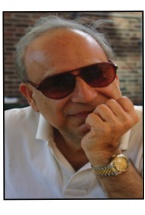Journey into America at the National Cathedral
By Lillie Cicerchia
 The National Cathedral in Washington DC stands as one of the great architectural icons of the American heritage.
The National Cathedral in Washington DC stands as one of the great architectural icons of the American heritage.
Standing as the sixth largest cathedral in the world, it presents a unique and beautiful view of America's capital city ranging from the suburbs to the mall and the Washington monument.
The October 25th showing of the film Journey into America, a documentary made by Professor Akbar Ahmed of American University, was appropriately shown in this setting on the seventh floor of one of the cathedral's towers. The stunning view contributed to a welcoming atmosphere, and the film itself is a unique perspective on the experience of the American Muslim community in the post 9/11 world. The integration of this experience with the Anglo-Saxon protestant experience that lead to the building of the National Cathedral created a beautiful fusion of the multiplicity of religious American Identity.
Journey into America is comprised of a wealth of experiences with American Muslims of all ethnicities, colors, and sects of Islam.
One subject in the early part of the film refers to Islam as being a religion for people of "all walks" of life. Interviews, observations, and experiments are used in a non-intrusive way to discover what American identity is, first off, and then how Muslims fit into the larger picture of America itself. Issues that challenge American values are put under fire as Professor Ahmed and his team from American University inquire as to what role racism and other prejudices play in the Muslim experience in America, as well as what American opportunity and the ever praised "melting pot" of American culture means to Muslims themselves.
Professor Ahmed was on hand to open the event with an introduction to the nearly packed audience.
He spoke of the need to understand the Muslims of America and America itself.
An interesting question asked of the two attending members of the Journey into America team was whether or not the Movie captured reality or only the "wackoids" of the American public. In response the team members pointed out that a great many people in the film simply admitted ignorance of the Muslim community rather than admitting to prejudice or racial stereotype, which is a moderate vantage point. There was a further interest in
why Muslims seem to be more discriminated against than other groups at this point in American history, and why such ignorance exists of the Islamic faith. The movie offers an answer in that before 9/11, the Muslim community had a relatively low profile as a minority faith in the American community, and its induction into mainstream American interest occurred under more than hostile circumstances.
The reactions of the attending audience to the film were resoundingly positive, and most displayed a sincere appreciation for the im portance of the film. There were suggestions for the film to be sent to all public schools in the area, to members of the legislature, and to the president, and was seen by the group as being a necessary view ing for Americans at large. Called a "kaleidoscopic experience" by one member of the audience, the film was received very well in total as positive contribution to interfaith dialogue and understanding in the United States and throughout the world.
-------------------------------------------------------------------------------------

